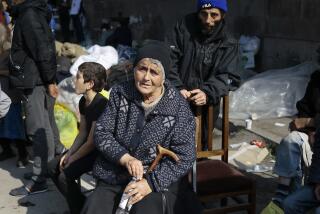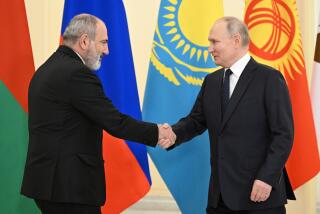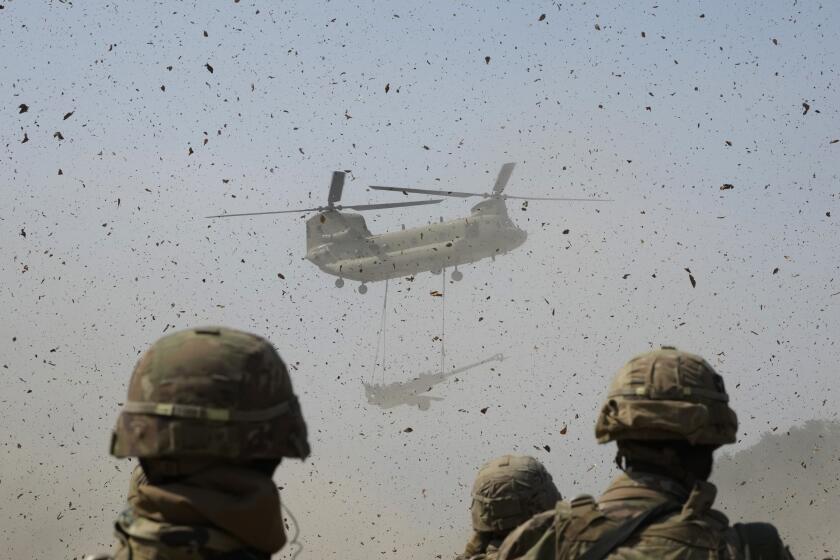Large-Scale Ethnic Protests Flare Up in Soviet Armenia
- Share via
MOSCOW — Mass demonstrations reportedly involving more than 100,000 people have flared up in the Soviet republic of Armenia, providing dramatic evidence of ethnic tension in the Soviet Union.
The disorder in Armenia and the large number of people said to be involved was reported Tuesday by dissident sources in Moscow. The Soviet press took the unusual step of confirming it but without specifying the size of the demonstrations.
The dissident sources said the Armenians were demonstrating in support of a demand for the return to Armenia of a region deeded in 1923 to the neighboring Soviet republic of Azerbaijan, even though more than 90% of the people in the region are Armenian. The region, situated in the Caucasus Mountains, is known as Nagorno-Karabakh.
The sources said that thousands of people had crowded into the streets around the opera house in Yerevan, the Armenian capital, a city of about 650,000 about 1,100 miles southeast of Moscow. Many of the demonstrators reportedly carried signs bearing the words “One People, One Republic.”
According to Izvestia, the government newspaper, there was a “noisy” demonstration in Yerevan to demand a special session of the Armenian legislature to discuss the Nagorno-Karabakh issue.
Armenia is one of the smallest of the 15 Soviet republics. Its people have a strong sense of national identity, nurtured by language, a long history of persecution and strong ties to the Armenian Catholic Church.
The people of Azerbaijan, on the other hand, include not only Azerbaijanis but Armenians, Russians, Georgians and Shia Muslims of Persian culture.
The demonstrations broke out over the weekend, and on Tuesday the head of the Communist Party of Armenia, Karen S. Demirchyan, appeared on television to appeal for calm. He ruled out any change in the status of the Nagorno-Karabakh region.
According to reports from Armenia, his words provoked cries of derision from crowds in the streets, loud whistling and shouts of “Liar!”
Soviet leader Mikhail S. Gorbachev has openly expressed displeasure with Demirchyan, who has refused to step aside. But his stand on the demonstrations was echoed in Moscow by the Central Committee of the national party.
Damage to Relations
The news agency Tass said the Central Committee “holds that the actions and demands directed at revising the existing national and territorial structure contradict the interests of the working people in Soviet Azerbaijan and Armenia and damage inter-ethnic relations.”
Tass said that officials in Moscow have instructed party leaders in Armenia and Azerbaijan to “take necessary measures for improving the existing situation.” It said they were told to “normalize the situation around Nagorno-Karabakh, guarantee public order and strict observance of socialist law.”
According to Izvestia, Georgy P. Razumovsky, a high-ranking Kremlin official, spelled out the party view personally at a meeting Monday in Stepanakert, the principal city in the Nagorno-Karabakh region.
The unrest in Armenia is the latest sign of strong nationalist feelings in the Soviet Union. These feelings run counter to the party line, which holds that the scores of ethnic groups live in “fraternal friendship.”
Not long ago Gorbachev proposed a special meeting of the Central Committee to deal exclusively with questions of nationality. But no date has been set for such a meeting.
Attention on Baltic States
Until the demonstrations broke out in Armenia, attention had focused on the Baltic states. Dissident Estonians have tried to form a political party and demonstrations had been planned for today, the anniversary of Estonian independence in 1918. Authorities in Moscow have said that no such demonstrations will be permitted.
The authorities have refused to allow Moscow-based reporters to travel to Estonia for the occasion and have charged that the Estonian dissidents are being encouraged by Western nations.
Provocation Charged
Tass, in its account of developments in Armenia, said that a “breaching of public order” had been “provoked as a result of irresponsible calls by extremist individuals.” According to dissident sources in Moscow, the demonstrating has been peaceful and without violence.
Tass said that earlier this month people living in the Nagorno-Karabakh region had proposed to the authorities that the region be transferred to Armenia. According to Izvestia, demonstrations and school boycotts began after a proposal to reconsider the question had been published in the local press.
Izvestia appealed for a calm, open discussion of the issue. It said the main concern is the general interest.
More to Read
Sign up for Essential California
The most important California stories and recommendations in your inbox every morning.
You may occasionally receive promotional content from the Los Angeles Times.













